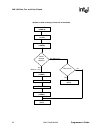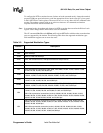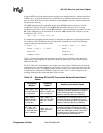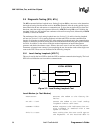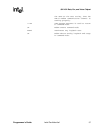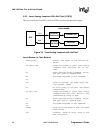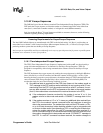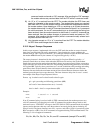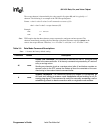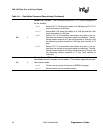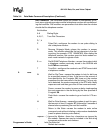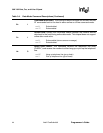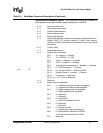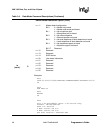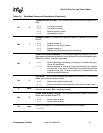
56K V.92 Data, Fax, and Voice Chipset
40 Intel Confidential Programmer’s Guide
command mode and sends an ‘OK’ message. After sending the “OK” message,
the modem echoes any received data from the DTE while in command mode.
2) An “A” or “a” is received from the DTE. The modem disables the EPD timer and
sends the character to the remote modem. The modem then stores any received
data from the DTE into the modem internal command buffer and sends the data to
the remote modem. Upon detecting a <CR> or receiving up to 39 data characters,
the modem determines if a valid AT command has been received; if so, it processes
the valid commands. If a non-AT command string or an invalid command string has
been received, then the modem remains in data mode. If a valid AT command has
been received, then the modem changes to command mode and sends an “OK”
message. After sending this, the modem (while in command mode) echoes back
any data received from the DTE.
3) Any character except an “A” or “a” is received from the DTE. The modem disables
the EPD timer and changes back to data mode.
3.10.2 Hayes
∗
Escape Sequence
In this escape sequence, implemented with +++, the DTE sends the modem an escape character
three times, preceded and followed by guard times. Upon detecting the escape sequence, the
modem sends an “OK” response to the DTE. To re-enter the online data state, the DTE then sends
the modem ATO followed by the contents of S-register S3 (typically a <CR>).
The escape character is determined by the value stored in S-register S2 and is typically a ‘+’
character. Guard times are silence times when the DTE does not send any data to the modem.
Guard times ensure that the modem does not falsely detect an escape sequence if three consecutive
escape characters are received from the DTE. The preceding and following guard times are defined
in S-register S12. Typically, these guard times are 1 second. In addition to the preceding and ending
guard times, there are inter-character time-outs between each escape character sent. The inter-
character time-outs define the maximum amount of time allowed between characters before the
modem ignores the previous escape characters. This inter-character delay time is set to 1 second.
An example of the Hayes Escape Sequence follows:
Format: <gt 1><char1><tm 2><char2><tm3><char3><gt4>
gt1 = gt4 ≥ preceding and following guard times (S12)
tm2 = tm3 ≤ inter-character time-out (= 1 second)
char1 = char2 = char3 = escape character (S2)
Example:
DTE: 1 second +++ 1 second
DCE: OK
If an AT command string is received while in TIES command mode, the modem processes any
valid AT command. Upon detecting an invalid AT command, the modem changes back to data
mode and issues a “CONNECT” message to the DTE. While in TIES command mode, the modem
ignores certain characters that may cause the modem to incorrectly decide that an incoming AT
string is invalid. The ignore characters are <LF>, <space>, and <CR> (<CR> is ignored only when
S3 is not equal to <CR>). Not all AT commands are supported during TIES command mode. The
following is a list of supported commands:
En, Hn, Mn, On, Qn, Sn, Vn, Xn, and ‘&’ commands (except &Tn and &F)



